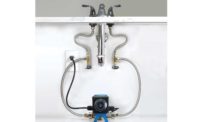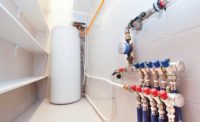David Jacques, P.E. CPD LEED AP BD+C, got a taste of how the other half lives and he didn’t enjoy it.
Jacques was working one afternoon on the 9th floor at Seattle’s King County Correctional Facility when an incident on a different floor forced a mandatory lockdown throughout the facility.
The senior mechanical engineer with Bellevue, Wash.-based engineering firm Wood Harbinger was left in a 7’ by 12’ holding cell for 15 minutes while the episode was handled by the prison’s correctional officers.
Jacques, all of the onsite engineering and construction team staff, and the contractor team, had to remain within sight of a prison officer escort at all times during the 22 months he spent there working on a re-piping project. Jacques followed all the rules, but that didn’t mean there weren’t anxious times.
“It was certainly intimidating. It’s a different feeling being in there than you might originally think from the outside,” he says. “I didn’t make eye contact with inmates. When you’re walking down the hall there are these eyes and faces pressed against the windows on the cell doors looking out at you.”
Tightening up
The KCCF became fully operational in 1986 with a domestic water delivery system constructed with copper piping. The nearly 386,000-sq.-ft. facility — which houses more than 1,000 inmates and employs more than 350 correctional officers — was just more than a decade into its use when the system began to spring leaks. Those leaks grew exponentially over the years.
The prison’s operations staff plugged holes and replaced small sections of pipe wherever possible, but by 2004 KCCF agreed that a full re-pipe was in order.
“Unfortunately, the water in the area is so aggressive that the county’s onsite plumbing staff found itself spending an inordinate amount of time fixing leaks in addition to their regular duties,” Jacques says.
David Morse, who has been the KCCF’s chief plumber for 18 years, says that the daily maintenance on the original system was incredibly frustrating.
“Two or three times a week, we’d have a pinhole leak and we’d put a patch on it or cut a section out and replace it,” he says. “Then two days later we’d have a new pinhole five feet from the original leak.”
Morse adds: “You could take one of the four-inch copper pipes and barely stick two fingers down the middle of it because of the calcification and growth inside the pipe. It was really bad.”
At that time, Wood Harbinger was commissioned to perform a full study as to why the system was leaking and provide drawings to replace the domestic water pipe. Initially, bids came in too high and the project was put on hold until the county could secure more financing.
Five years later, King County asked Wood Harbinger to update its original study and provide additional solutions to the problem. Jacques had pipe samples sent to a corrosion specialist. Woodinville, Wash.-based Norton Corrosion determined that hot water recirculation was in the worst condition, but the cold water system wasn’t much better.
It was decided the cold water system had 10-20 years of service left, but it didn’t make economic sense for the county to simply replace the hot water if in 15 years the same would have to be done with the cold water piping. The county wanted a solution that would last for the remaining life of the jail.
In July 2009, the county agreed on an immense renovation where $3.6 million would be spent on re-piping the prison. Jacques and King County selected Aquatherm polypropylene-random (PP-R) pipe for the overhaul.
The long expected lifespan — more than 50 years — and the overall protection Aquatherm’s PP-R pipe provided were the primary considerations, but total cost was also a key factor in making the final call.
“In the two years from the start of the initial study to the project’s beginning in July 2011, there were no Aquatherm price increases,” Jacques says. “Copper prices had jumped up and dropped, jumped up and dropped again. We had ‘X’ number of dollars to spend, and if Aquatherm had jumped up such as copper, it would have broken our budget.”
Jacques explains the PP-R pipe is heat-fused together, which means the pipe has lower leak incidents after installations.
“The joints are actually stronger than the pipe,” he says. “From a material standpoint, the primary benefit is that the polypropylene used in the pipe and fittings is more resistant to chemical corrosion and erosion than traditional copper piping.”
Balancing act
The KCCF consists of four towers of varying size and functionality needs. The West tower is eight stories tall, the South houses 15 floors, and the North and East towers are 17 stories apiece.
The North and East towers feature individual cells where inmates are isolated from each other. Each cell is served by a mechanical shaft located behind the plumbing fixtures.
“These cells are stacked 10 floors high with 26 cells on each floor,” Jacques states. “Therefore, there are 52 separate hot water recirculation sub-loops serving the cells in these two towers. All the sub-loops are eventually combined on the sixth floor.”
Jacques immediately saw the flaw in the prison’s original design, which fed a single, oversized hot water recirculation pump. The sub-loops had just a single 1/4-turn ball valve to balance the system.
“Ball valves are terrible for balancing because opening the valve a small amount will allow for a disproportionate amount of flow through the valve,” Jacques says. “This is known as poor valve characterization.”
Jacques kept the same number of sub-loops in the system, but modernized by providing each loop with 1/2 in. to 3/4-in. Griswold Controls pressure independent automatic balancing valves and Armstrong Fluid Technology balancing and measuring valves that range from 1-in. to 2-in. diameter. By doing so, the tower recirculation system utilizing the Griswold valves is self-balancing.
“A separate dedicated recirculation pump was provided for each tower,” Jacques says. “This reduced the effect of varying flows and distance between the towers. The new pumps were properly sized and matched for each tower resulting in a more efficient system.”
Jacques specified 6-in. Aquatherm Greenpipe for the cold water mains with 3-in. Greenpipe vertical risers serving the cell plumbing chases. Supply piping to the individual cells consists of 3/4-in. to 1 1/2-in. Greenpipe.
The hot water piping utilizes Greenpipe faser-composite, a thicker pipe with a 7.4 standard dimension ratio (pipe diameter to wall thickness). It includes an extruded core layer of fiberglass that increases the rigidity and working pressure of the pipe at higher temperatures. The glass fibers also significantly reduce the thermal expansion to a level similar to metallic pipe, which is beneficial when designing a piping system for hot water.
Jacques had only worked with Aquatherm’s product line once before, on a small rainwater reuse project at a local high school nowhere near as large or complex as the KCCF, but it was a smooth transition once other aspects of the project fell into place.
“I quickly became comfortable with the pipe and fittings,” he states. “Issues such as insulation (type and thickness), fire stopping, thermal expansion, hanger type and spacing, and flame and smoke spread ratings were challenges. These required approval from the local jurisdictions, most of those whom had not seen Aquatherm’s products ever before.”
Rise and fall
Another interesting caveat to the King County application is how the height of the buildings required different water pressures. The lower halves of the buildings had a low-pressure system (50 to 60 psi). The upper halves had higher pressure systems (90 psi).
“The first six floors could be served by the city’s water pressure,” Jacques says. “Since the force of gravity reduces the system pressure (static head) by about 5 psi for every floor upward, there would be insufficient water pressure on floors seven and higher.”
At the sixth floor mechanical room, existing booster pumps provided the needed pressure on the 17th floor.
“If the booster pumps were located on the first floor, in order to have a single pressure zone, floors one through six would be over-pressurized beyond the maximum pressure of 80 psi for the plumbing fixtures,” Jacques says.
Water- and energy-savings were not the primary focuses on the King County project, but Jacques provided a more balanced system that delivers domestic hot water throughout the facility.
“Some energy savings was provided by replacing two 1-hp hot water recirculation pumps with four 1/6-hp pumps,” Jacques says. “(That provided) for an overall motor power reduction of 67% for pumps that run 24 hours a day.”
Compact spaces
Jacques came across many challenges during the King County project. First, there were the aforementioned security companions which had to be included in the bidding process.
“The cost of additional security escorts was a substantial portion of the overall installation cost,” he says.
In addition, the installation had to be a “live” changeover, meaning many water pipes had to remain active and secure. A standard work day was between 10 p.m. and 6:30 a.m.
“The concrete shafts behind the cells remained the same. They were so small that there was not enough room to core through the floor to provide a parallel piping system in the shaft,” Jacques says. “Therefore, the 10 floors of piping in each shaft had to be demolished and replaced with PP-R utilizing existing core holes and returned to service by morning.”
The prison’s fixtures are stainless-steel with push-button controls and all the plumbing parts were mandated to be put behind the wall and secured in plumbing chases. In addition, the toilets have higher-than-normal flush volumes because inmates will intentionally make clogs to cause issues and flood their cell.
“When the cells flood, the water overflows into the exhaust air ducts and can create quite a mess beyond the inmate’s cell walls,” Jacques says.
Morse is pleased that after all this time the KCCF has a piping system he can trust.
“It cut our work on fixing leaks from daily to next-to-nothing,” he says.
When Jacques looks back on the project that he “lived and breathed for five years,” he is impressed with how the right plan came together from humble beginnings.
“That initial study convinced me rather quickly that (PP-R) is what the jail should use,” he says. “I was sticking my neck out there to the county to use a product that I had not used much before for such a large building. There were no other comparable buildings to go and look at beforehand.
“But, we made the right choices.”









